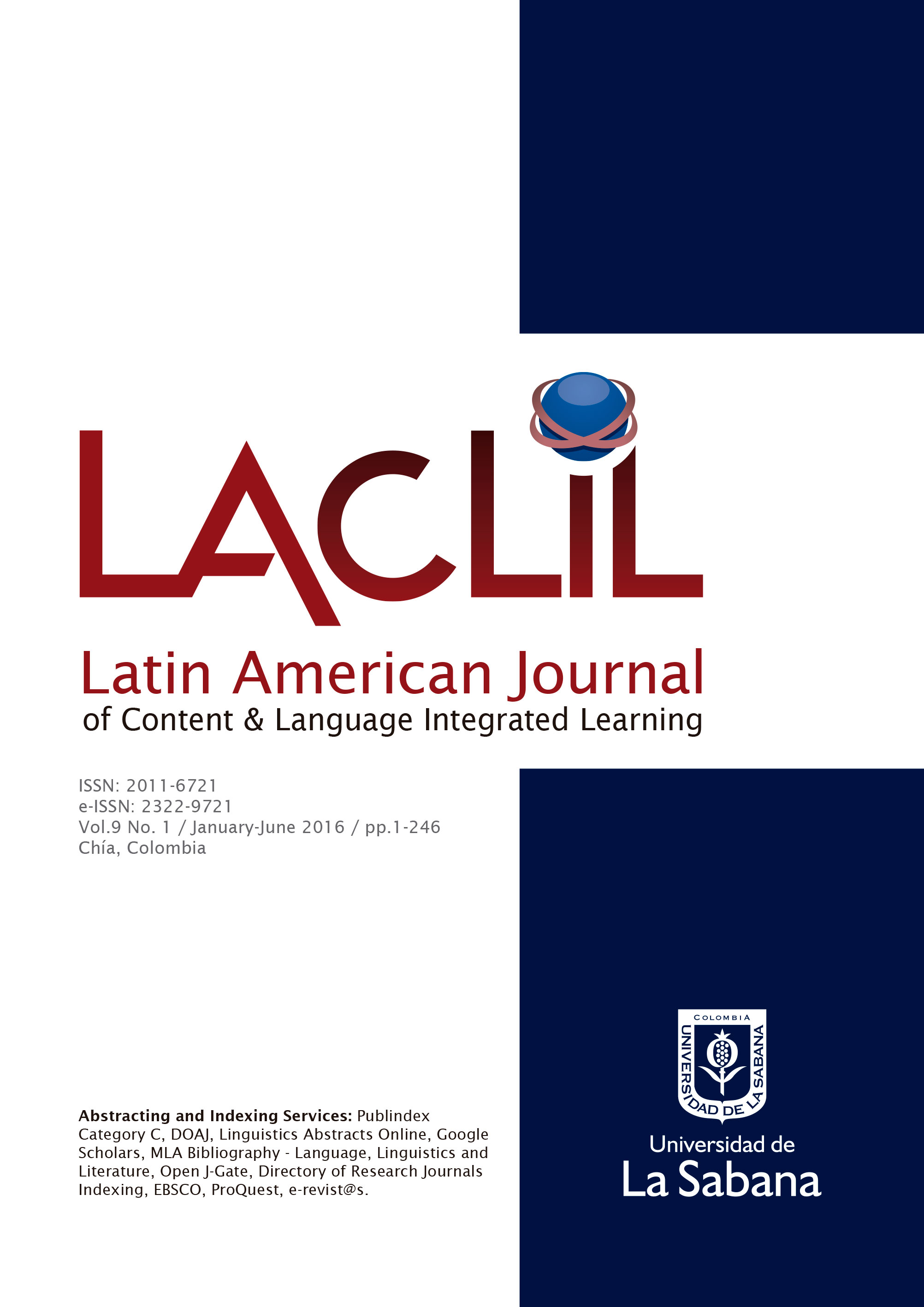The Effects of CLIL Education on the Subject Matter (Mathematics) and the Target Language (English)
DOI:
https://doi.org/10.5294/5493Keywords:
CLIL, multilingualism, cognition, mathematics, English.Abstract
This paper investigates the effects of Content and Language Integrated Learning,CLIL for short, on both the attainment of the subject matter, mathematics in ourcase, hence the content aspect of CLIL. The second axes of research focuses on theeffect of CLIL on the learners’ proficiency vis-à-vis the language of instruction,epitomized here by English- hence the linguistic aspect of CLIL education. Thispaper adopts a multiple approach methodology to deal with the research questionsat hand. I concluded on the basis of field work, this includes data coding andanalysis, questionnaire design and analysis, an administered mathematical test,and the teacher’s continuous assessment of his students, that CLIL education ismore effective than traditional educational systems in helping learners to achievehigh proficiency levels in the target language (English) and to attain high levelsof competence in the subject matter (mathematics). I believe these results mightbe explained by an existing of a covert tradeoff between the brain mechanismsinvolved in learning both mathematics and languages as well as by the pedagogicalopportunities, provided by CLIL environment, and which echo, to a great extent,L1 acquisition environment.
Downloads
References
Bibliography
Baker, C. & S. Prys Jones. (1998) Encyclopedia of Bilingulaism and Bilingual Education. Clevedon, Avon: Multilingual Matters.
Bamford, K. & Mizokawa, D. (1991) Additive-bilingual (immersion) education: Cognitive and language development. Language Learning 41(3), 413-429.
Bialystok, E. (2005) The Impact of Bilingualism on Language and Literacy Development. In (eds.) Bhatia, T. K & Titchie, W. C., Handbook of Bilingualism (2006) Oxford: Blackwell, 577-602.
Bialystok, E., F. Craik & M. Freedman. (2006) Blingualism as a protection against the onset of symptoms of dementia. Neuropsychologia 45, 459-464.
Burbaud, P. Degreze, P., Lafon, P., Franconi, J. M., Bouligand, B., Bioulac, et al.
(1995). Lateralization of prefrontal activation during internal mental calculation: A functional magnetic resonance imaging study. Journal of Neuropsychology, 74, 2194-2200.
Byrnes, J. P. (2001). Minds, Brains, and Learning: Understanding the psychological and
educational relevance of neuroscientific research. New York: Guilford Press.
Ceuleers, E. (in print) ‘Variable Identities in Brussels. Language learning, motivation and identity of adolescents in a Dutch-speaking school in Brussels”. Journal of Multilingual and Multicultural Development.
Cowell, S. F., Egan, G. F., Code, C., Harasty, J., & Watson, J. D. (2000). The functional
neuroanatomy of simple calculation and number repetition: A parametric PET activation study. Neuroimage, 12 565-573.
Dehaene, S., Spelke, E., Pinel, P., Stanescu, R., & Tsivkin, S. (1999). Sources of
Mathematical thinking: Behavioral and brain-imaging evidence. Science, 284, 970-974.
Du Bois. W. J, S. Schuetze-Coburn, S. Cumming,& D. Paolino (1993). Outline of discourse transcription. In J. Edwards & M. D. Lampert (eds) Talking Data: Transcription and Coding in Discourse Research. Hillsdale: Lawrence Erlbaum Association.
Edwards, J. A. (2007) The Transcription of Discourse: The Handbook of Discourse Analysis. Blackwell Reference Online.
Hiebert, J., & LeFever, P. (1987). Conceptual and procedural knowledge in mathematics: An introductory analysis. In J. Hiebert (ed.), Conceptual and procedural knowledge in mathematics (pp. 1-27). Hillsdale, NJ: Erlbaum.
Jappinen, A. K. (2005) Thinking and content learning of mathematics and science as cognitional development in content and language integrated learning (CLIL): Teaching through a foreign language in Finland. Language and Education. Vol. 19/2.
Lorenzo, F. S. Casal, & P. Moore (2009) The effects of content and language integrated learning in European education: Key findings from the Andalusian bilingual sections evaluation project. Applied linguistics. Oxford University Press: 1- 25.
Marsh, D. & D. Wolff (eds) (2007). Diverse Contexts- Converging Goals. CLIL in Europe. Frankfurt am Main: Peter Lang, 185-200.
Murray, D. R. (2010) Irish-medium language immersion programs’ effect on mathematics education. Journal of Mathematics Education at Teachers College, Fall-Winter Vol 1.
Van de Craen, P, E. Ceuleers & K. Mondt. (2007a). ‘Cognitive development and bilingualism in primary schools: teaching maths in a CLIL environment’. In: D. . Marsh & D. Wolff (eds) Diverse Contexts- Converging Goals. CLIL in Europe. . Frankfurt am Main: Peter Lang, 185-200.
Van de Crean, P., K. Mondt, L. Allain & Y. Gao. (2007) Why and How CLIL Works. An Outline for a CLIL Theory. Vienna English Working Papers 16(3), 70-78.
Van de Craen, P., K. Lochtman, E. Ceuleers, K. Mondt & L. Allain. (2007b). CLIL An
Interdisciplinary research approach to CLIL learning in primary schools in
Brussels. In: C. Dalton-Puffer & U. Smit (eds) Empirical Perspective on CLIL
Classroom Discourse. Frankfurt am Main: Peter Lang, 253-274.
Van de Cren, P., E. Ceuleers, K. Mondt & L. Allain. (2008). European multilingual
languages policies in Belgium and policy-driven research. In K. Lauridsen & D. Toudic (eds) Languages at Work Festschrift in Honour of Wolfgang Mackiewicz. Gottingen: V
Yen-Ling Teresa Ting (2010) CLIL Appeals to How the Brain Likes Its Information: Examples From CLIL-(Neuro)Science International CLIL Research Journal Vol (1) 3
Electronic references
http://www.sh-dilsen.be/joomla/
http://www.cs.columbia.edu/~sbenus/Teaching/APTD/Edwards_transcription_Handbook_of_DA.pdf
http://oxforddictionaries.com/definition/english/ethnography?q=ethnography
Downloads
Published
How to Cite
Issue
Section
License
This Journal and its articles are published under the Creative Commons CC BY 4.0 DEED Attribution 4.0 International license. You are free to: Share — copy and redistribute the material in any medium or format for any purpose, even commercially. Adapt — remix, transform, and build upon the material for any purpose, even commercially. The license cannot revoke these freedoms as long as you follow the terms of the license.








